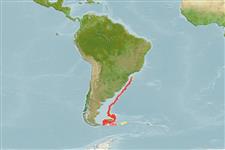>
Gadiformes (Cods) >
Macrouridae (Grenadiers or rattails)
Etymology: Coelorinchus: Greek, koilos = a hollow + Greek, rhyngchos = jaw (Ref. 45335).
Eponymy: Dr Tomás Leandro Marini (1902–1984) was an Argentine ichthyologist and fisheries biologist. [...] (Ref. 128868), visit book page.
More on author: Hubbs.
Environment: milieu / climate zone / depth range / distribution range
Ecología
marino bentopelágico; no migratorio; rango de profundidad 200 - 600 m (Ref. 1371). Deep-water; 26°S - 56°S, 64°W - 34°W (Ref. 1371)
Southwest Atlantic: southern Brazil to South Georgia.
Tamaño / Peso / Age
Maturity: Lm ? range ? - ? cm
Max length : 38.0 cm TL macho / no sexado; (Ref. 1371)
Espinas dorsales (total) : 0; Espinas anales: 0. The head large; the eyes also large; snout tipped with a scute of moderate size, not especially set off by its size or spines from the adjacent scales. Head ridges moderately supported by coarse scales. Most body scales with small fine, reclined spinules arranged in an irregular quincunx to sub parallel pattern. Overall color is medium brown to swarthy, darker on the abdomen and chest; the underside of the head with small melanophores; the fins are dusky, their inner bases black.
Frequently occurs below 350 m depth in winter. Feeds on benthic crustaceans and polychaetes (Ref. 54164).
Life cycle and mating behavior
Madurez | Reproducción | Puesta | Huevos | Fecundidad | Larva
Cohen, D.M., T. Inada, T. Iwamoto and N. Scialabba, 1990. FAO species catalogue. Vol. 10. Gadiform fishes of the world (Order Gadiformes). An annotated and illustrated catalogue of cods, hakes, grenadiers and other gadiform fishes known to date. FAO Fish. Synop. 125(10). Rome: FAO. 442 p. (Ref. 1371)
IUCN Red List Status (Ref. 130435: Version 2024-1)
Threat to humans
Harmless
Human uses
Herramientas
Special reports
Download XML
Fuentes de Internet
Estimates based on models
Preferred temperature (Ref.
123201): 3.3 - 14.6, mean 4.6 °C (based on 47 cells).
Phylogenetic diversity index (Ref.
82804): PD
50 = 0.5000 [Uniqueness, from 0.5 = low to 2.0 = high].
Bayesian length-weight: a=0.00219 (0.00126 - 0.00381), b=3.17 (3.02 - 3.32), in cm total length, based on LWR estimates for this species & Genus-body shape (Ref.
93245).
Nivel trófico (Ref.
69278): 4.2 ±0.3 se; based on diet studies.
Resiliencia (Ref.
120179): Bajo, población duplicada en un tiempo mínimo de 4.5-14 años (Preliminary K or Fecundity.).
Fishing Vulnerability (Ref.
59153): Low to moderate vulnerability (28 of 100).
Climate Vulnerability (Ref.
125649): Low to moderate vulnerability (26 of 100).
Nutrients (Ref.
124155): Calcium = 21.3 [11.6, 49.8] mg/100g; Iron = 0.366 [0.166, 0.729] mg/100g; Protein = 15.7 [13.5, 18.1] %; Omega3 = 0.232 [0.104, 0.526] g/100g; Selenium = 18.5 [7.3, 44.3] μg/100g; VitaminA = 30.7 [6.4, 143.4] μg/100g; Zinc = 0.406 [0.264, 0.632] mg/100g (wet weight);
